The mood as lockdown continues — week five of the coronavirus sentiment tracker
Our friends at About Loyalty bring you a summary of how people across the UK are feeling about the ongoing coronavirus pandemic, subsequent lockdown and charitable giving.
- Written by
- Richard Spencer
- Added
- April 30, 2020

It cannot be said too frequently: first and above everything else, I hope that you, your family, friends and colleagues are well and keeping safe during these extraordinary times.
A lot has changed in our lives. And there is more to come. This isn’t intended to shock, because fundamentally we all know it’s coming. If lockdown is extended further, economic, social and psychological impacts will increase. If lockdown restrictions are eased, then this will bring with it a new dynamic of change and again this is a change for which people are not fully prepared.
This short briefing brings together and simplifies the key developments over the first five weeks of lockdown, and outlines how they have brought us to this point. And of course, what we can do.
Massive, rapid change
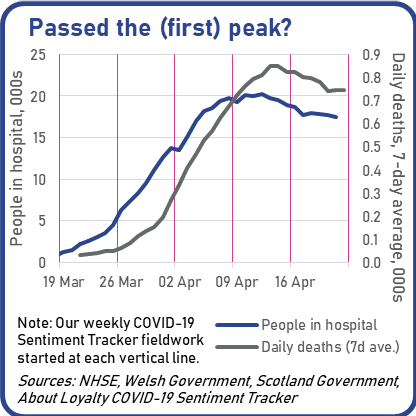
Who could have imagined only two months ago that we’d be ‘OK’ with being instructed to stay at home, not to go out to pubs, cinemas, or to visit and care for elderly relatives?
There would have been an uproar.
But in the face of COVID-19, we’ve accepted and embraced these seismic changes to our lives.
Our fieldwork started a week before lockdown and we’ve been monitoring the massive, rapid changes to our practical lives and our emotional state throughout.
We may be near or even past a (first) peak, but COVID-19 is still the biggest challenge that more than one in every seven people has ever faced. It continues to bring sustained levels of worry, anxiety and fear of the outside world.
How much will go back to ‘normal’?
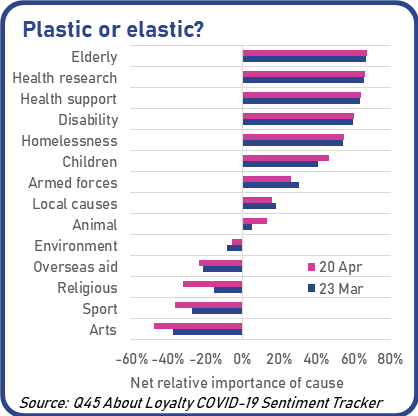
People are re-evaluating what is important to them (during and) in the aftermath of COVID-19. We have seen this in the causes that they are saying are more important to them today, and those that are less important.
We describe change as either plastic or elastic. If something goes through elastic change, it springs back to as it was before. Plastic change is permanent.
Some of the change we’re going through will be elastic, and go back to ‘the old normal’. However, some change will be plastic.
It is likely that this change, positive for some sectors and negative for others will be permanent with at least some people.
Consumer confidence; optimism bias
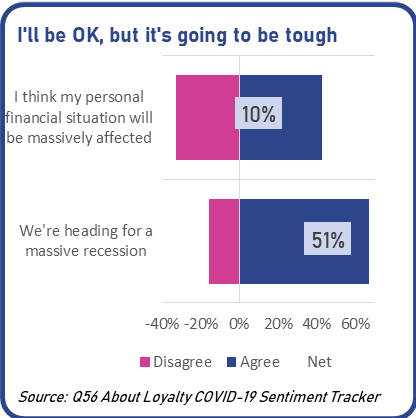
If something scary happens ‘out there in the outside world’ it’s a common response for some to genuinely believe that they will not be impacted. This is known as ‘optimism bias’.
As I write this, one in four people are furloughed, more companies will become bankrupt and people are losing jobs.
A net 51 per cent people believe that we’re heading for a massive recession. But only a net ten per cent think that they themselves will be massively affected.
This could imply that if/when an anticipated massive recession arrives, many people will be hit harder because they will not have been expecting to be affected.
We’d expect this: it’s part of change
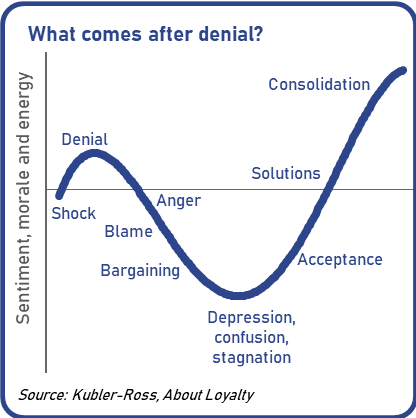
The Kübler-Ross change curve describes the changes in morale and energy that someone experiences over time following a sudden change or shock.
Through our fieldwork, we’re seeing clear evidence of the change curve in action.
We’ve seen and are still seeing evidence of shock. We’re also seeing elevations in morale and energy (associated with denial) and a desire to express our shared humanity. Captain Tom Moore raised nearly £30m for the NHS, people in Italy are singing from their balconies and in the UK millions are clapping on their doorsteps every week for NHS workers. Awareness of a looming recession is growing, but many believe that they will not be affected themselves.
Around the world, we’re witnessing protests against lockdown that in some places have already turned into riots. How will this unfold in the UK? We’re already seeing a decline in net trust in the government (down from 43 per cent at the end of March to 26 per cent by 20th April) and people are mourning their old lives. Many are fed up.
It’s inevitable that we will enter a phase in which people express anger and blame. We will start to see people blaming their preferred villains (the devil you know): politicians, Brexiteers, Trump, Boris, China, the lefties, vegans, hoodies, boomers – whoever. Maybe even charities?
And perhaps more worryingly, we will see people move towards the bottom of the change curve, associated with lethargy and a lack of action.
Positive charitable indicators
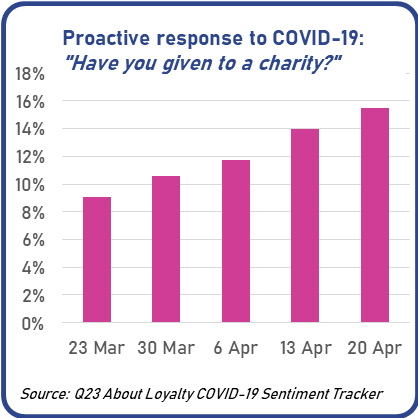
Whilst we have a potential economic tsunami heading our way, over the short-term there are some positive indicators that the UK’s strong, natural, charitable instinct is alive and well.
Net optimism is positive and growing – we started lockdown at five per cent and as of 23rd April this was at 16 per cent. However, it has a long way to go before it reaches the pre-coronavirus levels (+45 per cent in January).
We’re seeing people agree with the hope that communities will come together and that they are heartened by the way that people have already come together so far.
People are also looking at this as an opportunity and that we’ll emerge stronger as a family, nation and planet.
Net trust in charities is high and sustained at around 41 per cent for the full five weeks from lockdown to 23rd April. And in terms of reported behaviour, the proportion of people who have given to a charity as a response to coronavirus has increased by over 70 per cent.
Some of this increase will be a direct measure of Captain Tom Moore’s NHS fundraiser, and as we’ve already discussed, some of this boost to our charitable instinct will be plastic i.e. it will be permanent!
It’s still all about the experience
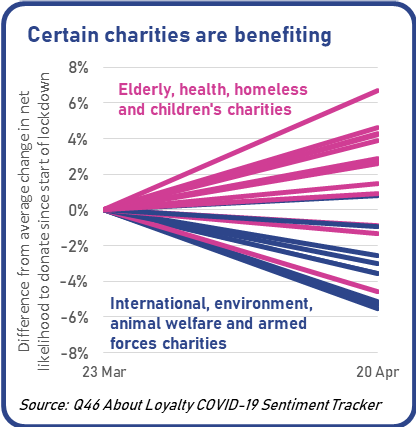
We ask people how likely they are to donate to specific named charities. We can see that since lockdown, those charities working for health, elderly and homeless have seen the likelihood of receiving donations consistently tracking above average. Whilst those working for international, environment and animal welfare are consistently tracking below. That is some positive news for some charities at the expense of others.
However, any recession, rise in unemployment or economic collapse will have a direct impact on all charities.
Whatever your cause, the supporter experience can always be inspiring, motivating and give supporters the comfort that you, as a charity they support, recognise, value and love them and all that they give. If we’re committed to respecting supporters and their contributions, then now is the time to give back to them.
We wouldn’t treat our loved-ones, families and friends any differently so why not our supporters?
Take care and keep safe.

















